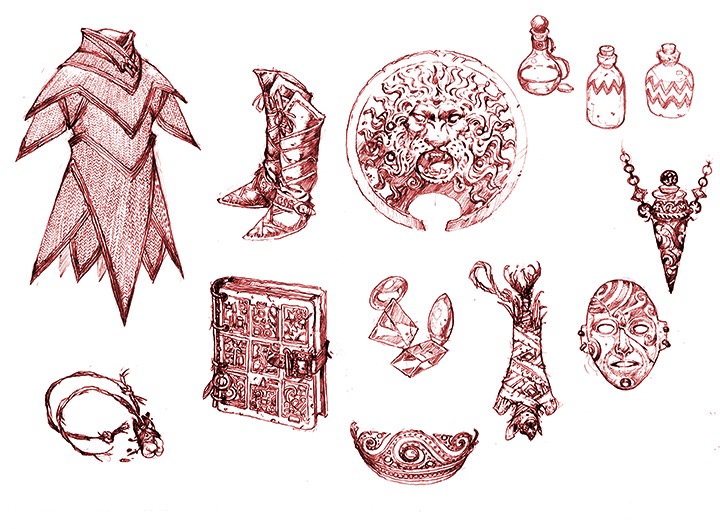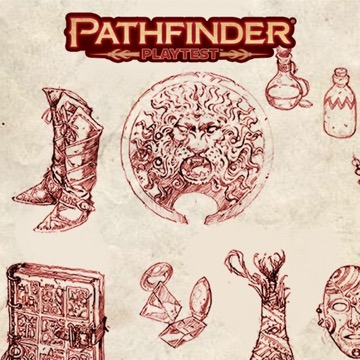In Monday's blog, we talked about weapons and all the plentiful options you have when you're picking those. So let's stay in the Equipment chapter for the Pathfinder Playtest Rulebook and take a look at armor, other gear, and everything else having to do with items!
Don Your Armor!
Armor's job is to protect you from your enemies' attacks. Your character can have proficiency in light armor, medium armor, or heavy armor (or, in some cases, none of the above). Most classes are only trained in their armor at first, though some martial classes gain better proficiency at higher levels. In Pathfinder First Edition, many types of armor were effectively obsolete because you could just buy a better type, but for Pathfinder Second Edition, we've made a few new adjustments to make each type a little different.
A suit of armor has many of the same statistics as in Pathfinder First Edition, but now each one also gives a bonus to your TAC (Touch Armor Class). For instance, studded leather gives a +2 item bonus to AC and +0 to TAC, whereas a chain shirt gives a +2 item bonus to AC and +1 to TAC, but it is heavier and noisier. That last bit comes from the noisy trait, one of a small number of traits some armors have to reflect their construction and effect on the wearer. Armor also has a Dexterity modifier cap (which limits how much of your Dexterity modifier can apply to your AC); a check penalty that applies to most of your Strength-, Dexterity-, and Constitution-based skill checks; a penalty to your Speed; and a Bulk value. You'll balance these variables to pick the armor that's best for you.
As you adventure, you'll find or craft magic armor. Weapons and suits of armor alike can be enhanced with magical potency runes. For weapons, a potency rune gives an item bonus on attack rolls and increases the number of damage dice you roll on attacks with the weapon. For armor, the potency rune increases the armor's item bonuses to your AC and TAC and gives you a bonus to your saving throws! For instance, studded leather with a +3 armor potency rune (a.k.a. +3 studded leather) would give you +5 AC, +3 TAC, and +3 to your saves. You can also upgrade the potency later, etching a +4 armor potency rune onto that armor to increase its bonus. You can even upgrade the potency of specific armor (and weapons) so you can hold on to your celestial armor at higher levels. If you don't wear armor, not to worry! Your bracers of armor give you a bonus to AC, TAC, and your saves without requiring you to clad yourself in a clunky metal box. They might not protect you quite as well, but maybe that trade-off is worth it to your wizard or monk!

Illustrations by Wayne Reynolds
Shield Yourself!
You've probably seen mention of shields in previous blogs, announcements, and broadcast play sessions. To gain the benefits of a shield, you have to spend an action to raise it, which then gives you a bonus to AC and TAC (+1 for a light shield or +2 for a heavy shield) for 1 round. Your character has proficiency in shields just like she does with armor, and when using a shield, you use the lower proficiency rank of your armor or shield to calculate your Armor Class.
Shields don't have potency runes. Instead, you might pick up a shield made of a durable material like adamantine or craft a magic shield that catches arrows, reflects a spell back at its caster, or bites your enemies!
Fill Your Backpack!
The Equipment chapter also includes all sorts of other gear you might want on adventures, from rope to tents to musical instruments to religious symbols. Many of these items are required to perform certain tasks, like thieves' tools. The new system of item quality makes it pretty straightforward to figure out how tools work. For example, you need thieves' tools to pick a lock or disable many traps. Normal thieves' tools let you do this normally, expert-quality tools give you a +1 item bonus on your check, and master-quality tools give you a +2 item bonus on your check. Now what if you get stuck without your tools and need to improvise? Well, if you can scrabble something together, you've created a poor-quality set of tools, which gives you a -2 item penalty (much like the penalty for having an proficiency rank of untrained in a task). The same thing might happen if you had to turn vines into improvised rope or use an empty chest as a drum for an improvised musical instrument!
Take a Load Off!
Not everything you can purchase is adventuring gear. Cinco de Cuatro wouldn't be complete without some luxuries like a bottle of fine wine or renting an extravagant suite! You might even rent an animal to ride about town. Of course, an extravagant lifestyle can have a high cost, and the chapter includes costs of living per week, month, or year so you can accurately budget your lifestyle decisions.
Switch It Up!
One of the squidgy parts of Pathfinder First Edition we wanted to clear up with the redesign is how holding, wielding, and stowing items work, particularly switching how many hands you're using for an item. Now, drawing an item from a pouch, changing your grip from one-handed to two-handed, or detaching a shield from your arm all require the Interact action. We've codified the rules for many of the basic things you do with items so the other rules interface with them cleanly. That [[A]] code you see there indicates this is an action, and will be a lovely icon in the final rulebook!
[[A]] Interact
Manipulate
You use your hand or hands to manipulate an object or the terrain. You grab an unattended or stored object, open a door, or do some similar action. You may have to attempt a skill check to determine if your Interact action was successful.
The equipment chapter also covers the full rules on item quality and on Bulk, plus a section on how items and Bulk work for creatures of different sizes.
Now you have a basic rundown of the gear in this book. We'll dive deep into magic items at a later date. Looking at what you see here, what sort of useful, peculiar, or silly things do you think your character will spend their silver pieces on?
Logan Bonner
Designer









